You are here
New Releases

AGAINST ALL ODDS
This assessment report is the sixth regional external assessment of UNFPA humanitarian programming in the Syrian and Arab States region (incorporating responses to the Syria crisis within Türkiye and cross-border from Türkiye to Syria and UNFPA humanitarian responses in Sudan and Yemen) to report on the impact on women, girls, boys, and men that UNFPA programming has had, across sexual and reproductive health (SRH), gender-based violence (GBV) and youth programmes. This 2022 assessment builds upon the previous annual impact assessments from 2016 onwards, tracking the evolution of programming through the evolution of the Syrian crisis, the COVID-19 pandemic, and for 2022, incorporation of UNFPA humanitarian response work in the countries of Sudan and Yemen.
The findings of the assessment are intended to inform UNFPA programmes, with the overall aim of enhancing the services that UNFPA provides. These findings will also be considered when designing new programmes or amending existing programmes. This report also informs the donor community to gain a better understanding of UNFPA’s operations in both the Syria regional response and the wider Arab States region.
The 2022 Impact Assessment builds on the established methodology of the 2021 Impact Assessment which rationalised and systematised the different tools and questions previously used to conduct research among three types of service delivery points (SDPs) with three primary research tools: Client Feedback Forms (CFFs) among attendees at services, Focus Group Discussions (FGDs) among attendees at services and Key Informant Interviews (KII) with institutional stakeholders – partners, service providers, UNFPA staff. The table below summarises the number of each type of research tool applied.
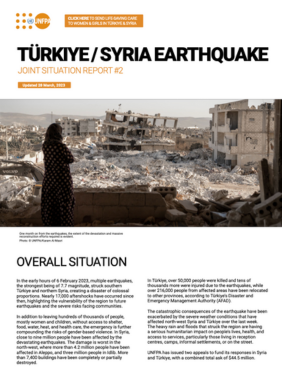
Türkiye-Syria Earthquake Joint Situation Report # 2
In the early hours of 6 February 2023, multiple earthquakes, the strongest being of 7.7 magnitude, struck southern Türkiye and northern Syria, creating a disaster of colossal proportions. Nearly 17,000 aftershocks have occurred since then, highlighting the vulnerability of the region to future earthquakes and the severe risks facing communities. In addition to leaving hundreds of thousands of people, mostly women and children, without access to shelter, food, water, heat, and health care, the emergency is further compounding the risks of gender-based violence. In Syria, close to nine million people have been affected by the devastating earthquakes. The damage is worst in the north-west, where more than 4.2 million people have been affected in Aleppo, and three million people in Idlib. More than 7,400 buildings have been completely or partially destroyed. In Türkiye, over 50,000 people were killed and tens of thousands more were injured due to the earthquakes, while over 216,000 people from affected areas have been relocated to other provinces, according to Türkiye’s Disaster and Emergency Management Authority (AFAD). The catastrophic consequences of the earthquake have been exacerbated by the severe weather conditions that have affected north-west Syria and Türkiye over the last week. The heavy rain and floods that struck the region are having a serious humanitarian impact on people’s lives, health, and access to services, particularly those living in reception centres, camps, informal settlements, or on the street. UNFPA has issued two appeals to fund its responses in Syria and Türkiye, with a combined total ask of $44.5 million.
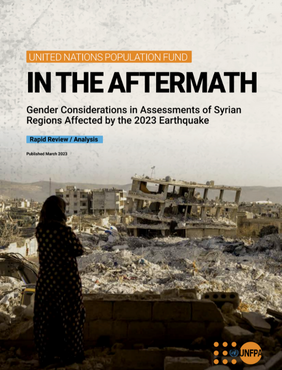
IN THE AFTERMATH - Gender Considerations in Assessments of Syrian Regions Affected by the 2023 Earthquake
On 6 February 2023, a magnitude 7.8 earthquake and multiple severe aftershocks struck Syria and Turkey, affecting multiple governorates including Idlib, Aleppo, Lattakia, and Hama. Prior to the earthquake, 15.3 million people were estimated to be in need of humanitarian assistance throughout Syria. For most Syrians, this earthquake only compounds existing suffering; 15 March marks 12 years since the start of the conflict which has caused massive displacement, economic collapse, and widespread violence. With approximately 1.9 million people living in around 1,430 camps or self-settled sites in the north-west of Syria (NWS), with 80 percent (1.5 million) being women and children. Syria remains the world's largest internal displacement crisis. The earthquakes have caused new internal displacement movements and at least 86,000 people were reportedly newly displaced since the earthquake happened.
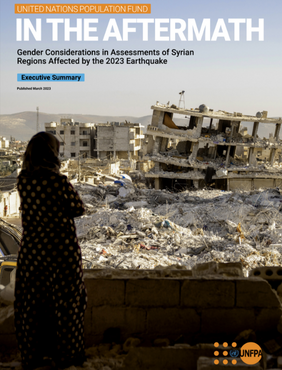
IN THE AFTERMATH - Gender Considerations in Assessments of Syrian Regions Affected by the 2023 Earthquake "Executive Summary"
On 6 February 2023, a magnitude 7.8 earthquake and multiple severe aftershocks struck Syria and Turkey, affecting multiple governorates including Idlib, Aleppo, Lattakia, and Hama. Prior to the earthquake, 15.3 million people were estimated to be in need of humanitarian assistance throughout Syria. For most Syrians, this earthquake only compounds existing suffering; 15 March marks 12 years since the start of the conflict which has caused massive displacement, economic collapse, and widespread violence. With approximately 1.9 million people living in around 1,430 camps or self-settled sites in the north-west of Syria (NWS), with 80 percent (1.5 million) being women and children. Syria remains the world's largest internal displacement crisis. The earthquakes have caused new internal displacement movements and at least 86,000 people were reportedly newly displaced since the earthquake happened.
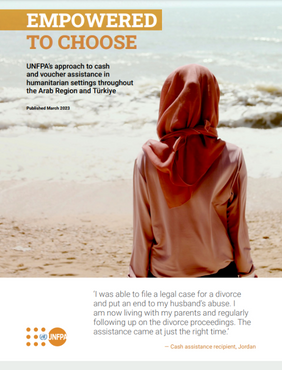
Empowered to Choose
This vital brief provides a comprehensive but succinct background on some of the commitments, considerations, and lessons learned surrounding the cash and voucher assistance (CVA) operations in the region and evidence from the field to reinforce main conclusions.
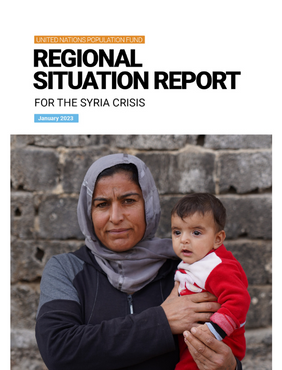
UNFPA Regional Situation Report For the Syria Crisis — January 2023
As of early 2023, Syrians and host communities throughout the region prepare for one of the worst years of the crisis. People in need continue to face the escalating impact of a protracted conflict, further complicated by a collapsing economy, climate-related challenges, and chronic and emerging health threats, including an unrelenting pandemic and a worsening cholera outbreak.

Türkiye-Syria Earthquake Joint Situation Report # 1
In the early hours of 6 February 2023, multiple earthquakes struck southern Türkiye and northern Syria, creating a disaster of colossal proportions. Since the two devastating earthquakes, nearly 17,000 aftershocks occurred until March 13. In addition to leaving hundreds of thousands of people, mostly women and children, without access to shelter, food, water, heat, and health care, the emergency is further compounding the risks of gender-based violence.
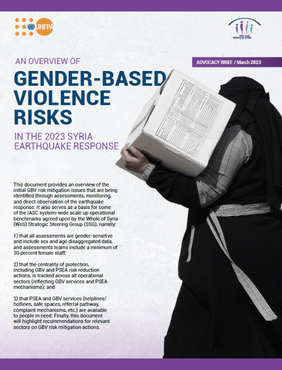
An overview of gender-based violence risks in the 2023 Syria earthquake response
This document provides an overview of the initial gender-based violence risk mitigation issues that are being identified through assessments, monitoring, and direct observation of the earthquake response. It also serves as a basis for some of the Inter-Agency Standing Committee (IASC) system-wide scale-up operational benchmarks agreed upon by the Whole of Syria Strategic Steering Group (SSG).

UNFPA Whole of Syria Situation Report #6
More than a month has passed since a magnitude 7.8 earthquake struck Syria and Türkiye on 6 February, impacting the governorates of Idlib, Aleppo, Lattakia, and Hama. Another magnitude 6.3 earthquake struck on 20 February, resulting in additional damage and trauma to affected communities. Prior to the earthquake, 15.3 million people were estimated to be in need of humanitarian assistance throughout the country. Recurring earthquakes also underscore the severe vulnerability and risks in these hard-hit regions. Aid workers and organisations have also been impacted by losses on many levels, which has affected their operational capacities. While casualty figures are increasing every day, more than 5,900 fatalities were reported across Syria as of February 12, most of which (more than 4,500) have been registered in the country’s north-west. Over 12,000 injured persons have also been reported. Damaged health care facilities resulted in a lack of essential lifesaving care services. Increased referral times to functioning hospitals and reduced capacity of trained providers has impacted access to care for both normal and urgent deliveries and increased the risks of otherwise preventable maternal morbidity and mortality. Access to comprehensive reproductive health services, including family planning, has been disrupted, which is contributing to increased morbidity and mortality, as well as psychological and mental health distress. Despite the extensiveness of the needs and the scale of the suffering caused by this tragedy, UNFPA remains committed to exercising its duty of care towards all its staff members and those of its partners in Syria. In addition to adopting rigorous protocols to guarantee the physical safety of all personnel, UNFPA and partners are ensuring the availability of resources and services to safeguard the psychological well-being of all individuals involved in the response.
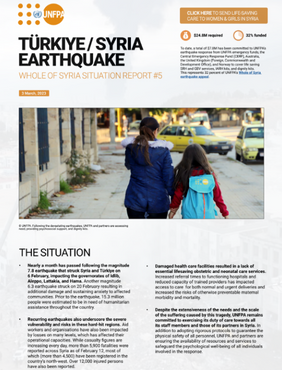
UNFPA Whole of Syria Situation Report #5
Nearly a month has passed following the magnitude 7.8 earthquake that struck Syria and Türkiye on 6 February, impacting the governorates of Idlib, Aleppo, Lattakia, and Hama. Another magnitude 6.3 earthquake struck on 20 February resulting in additional damage and sustaining anxiety to affected communities. Prior to the earthquake, 15.3 million people were estimated to be in need of humanitarian assistance throughout the country.